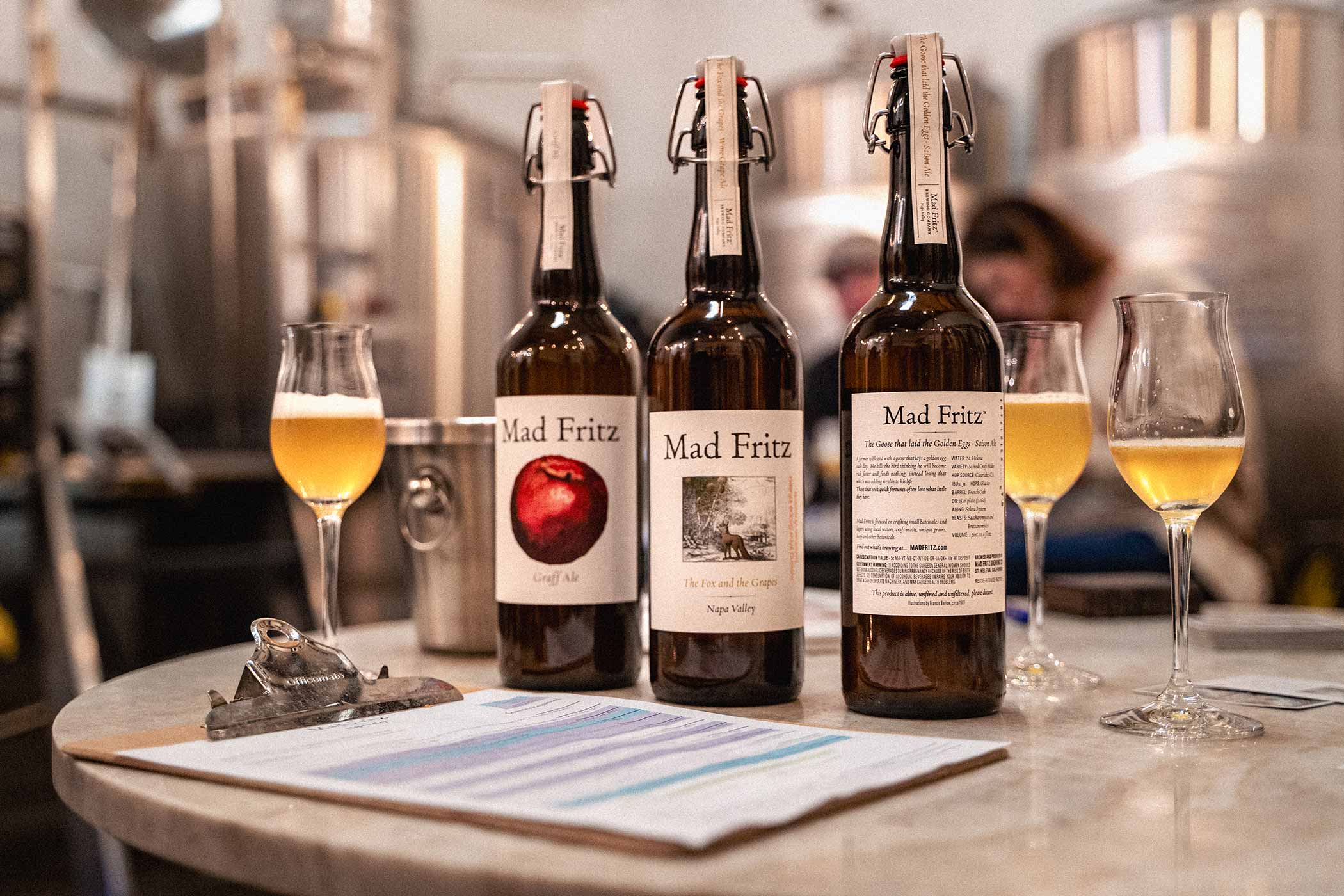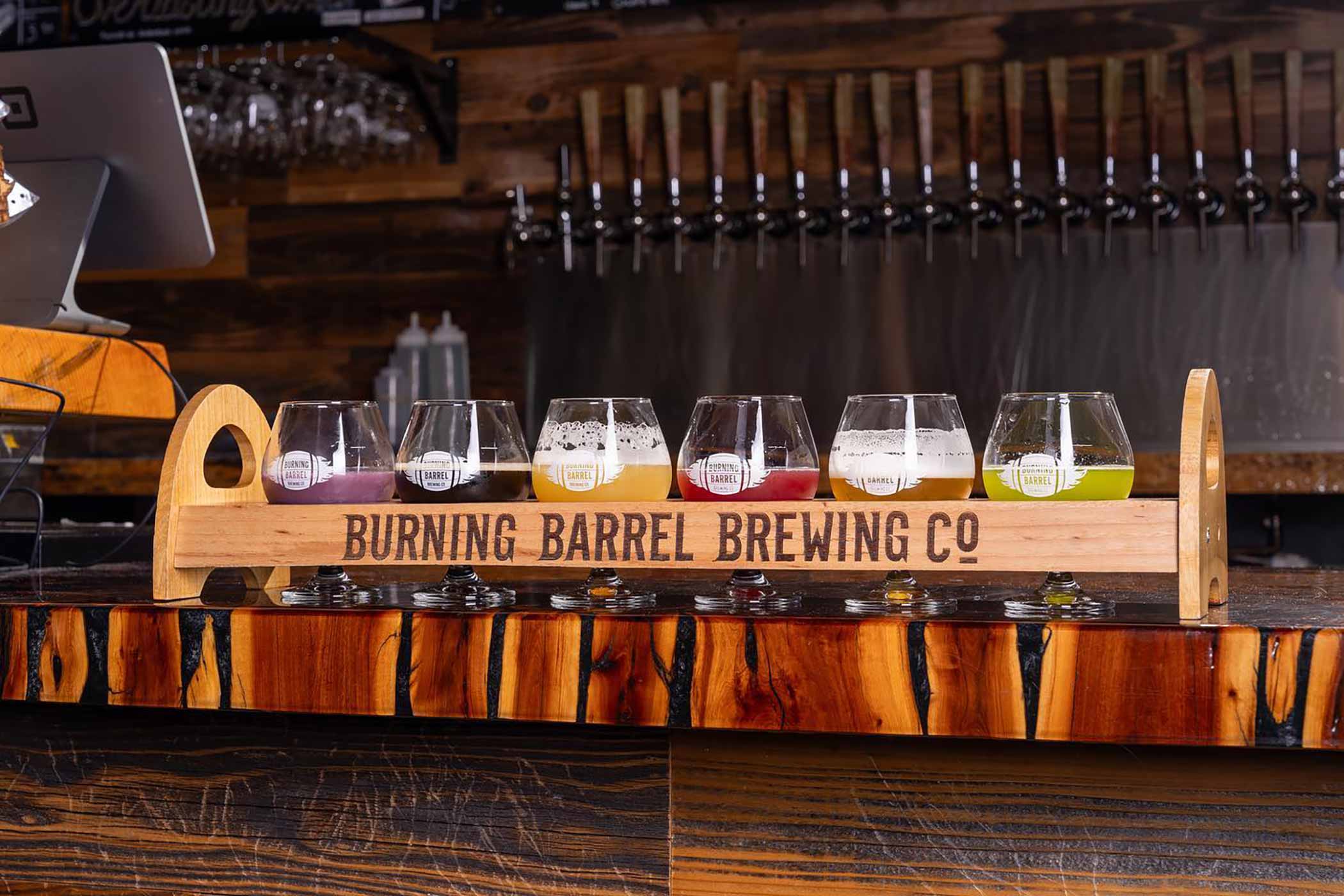Shop
Mad Fritz: The Mad Scientist Behind One of Napa Valley’s Best-Kept Secrets
Beer with heart, soul, and origin.
Hop Culture's Hottest Articles:
Some pages were weathered by time, stained and streaked with dirt, or patched with crumbling masking tape. Each filled with slightly illegible handwritten notes in black, navy, and sometimes green ink under sections like “Instructions/Comments” or “Ingredient.”
”Strike heat at 165° F”
“Mash out at 165° F covered 5 min.”
“Cascade 7gms.”
“Taking a long time to clear. Taste after ten days is strange but smooth”
Some pages, next to names like “Mokapu Lite,” “Orange Blossom Mead,” and “Porter Gulch,” featured handwritten drawings. Others were lopsidedly xeroxed.
At the top, two simple words: “HOMEBREW RECIPE.”
As Mad Fritz Co-Owner Nile Zacherle flipped each page of his black homebrew binder, it was as if you were stepping through the pages of Zacherle’s life.
What started as recipes like High Honey Lager and People’s Pilsner in college have morphed into The Wolf in Sheep’s Clothing, one of our “Top Fifteen Beers We Drank in March,” and The Goose that Laid the Golden Egg at one of Napa Valley’s best-kept-secret breweries.
Available by appointment only at a tasting room in St. Helena, CA, or through a membership club, the beers at Mad Fritz have become fabled. Lore passed down through the grapevine, which in my case was Hop Culture Social Media Manager Magic Muncie, who had made a date to visit after he had heard whispers about their phenomenal and unique beers.”
“I had so much fun the last time I was here; It really stuck with me,” Muncie said, who convinced me to drive an hour north early on a Saturday morning. “Like, goosebumps-type situation.”
After spending over three hours with Zacherle at Mad Fritz, there is only one way I can describe the silver-haired brewer, maltster, and roaster extraordinaire: mad scientist.
Each Homebrew Recipe, A New Page
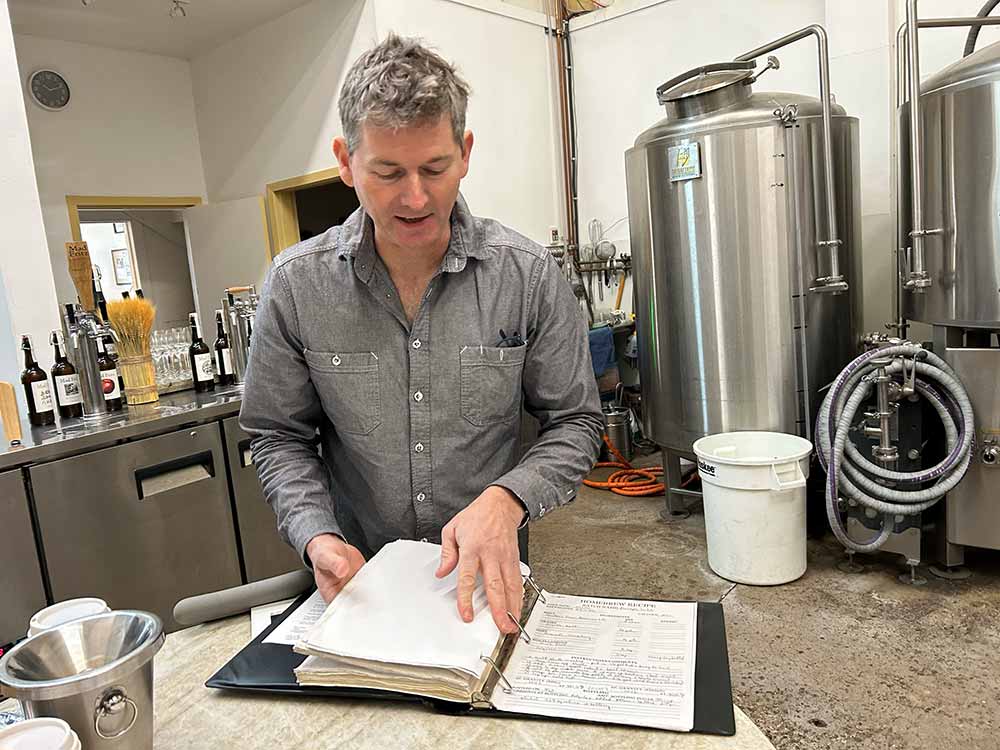
Photography courtesy of Grace Lee-Weitz | Hop Culture
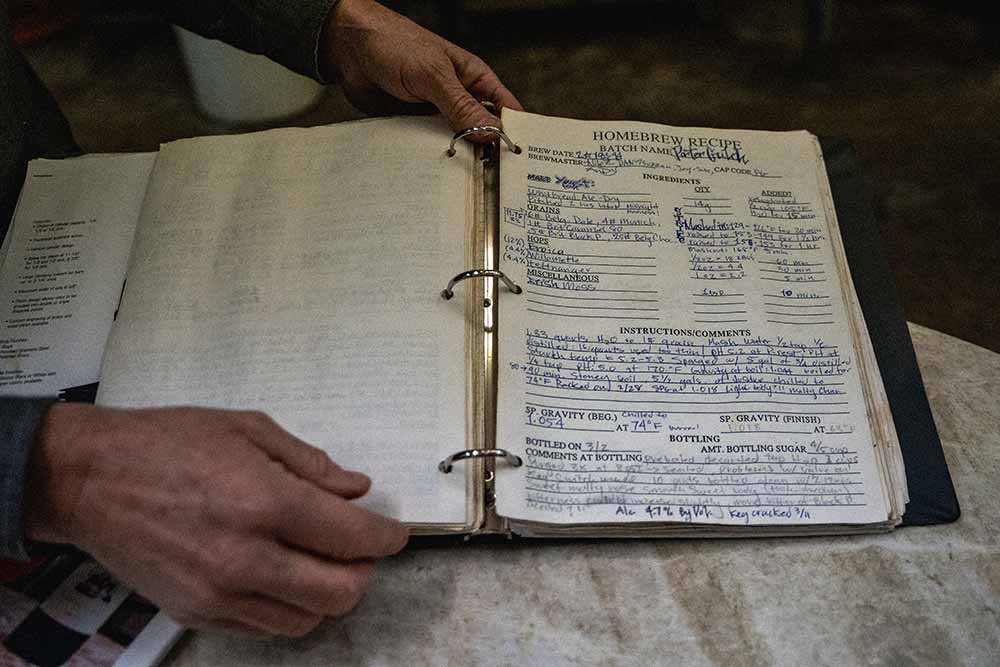
Photography courtesy of Magic Muncie | Hop Culture
A trip to North Coast Brewing Company in 1990 turned Zacherle to craft beer. After tasting a few samples with his dad, Zacherle said, “Sweet, can we do this?”
Returning home to Hawaii, the pair started homebrewing together. “There was a store in Honolulu where you could buy these cans of extract, so we made some crappy beers,” he laughed.
One of the first batches of Mokapu Light, brewed in 1991, was named after the road where the Zacherles lived.
At Cabrillo College, about thirty minutes outside Santa Cruz, CA, Zacherle continued homebrewing with his roommates.
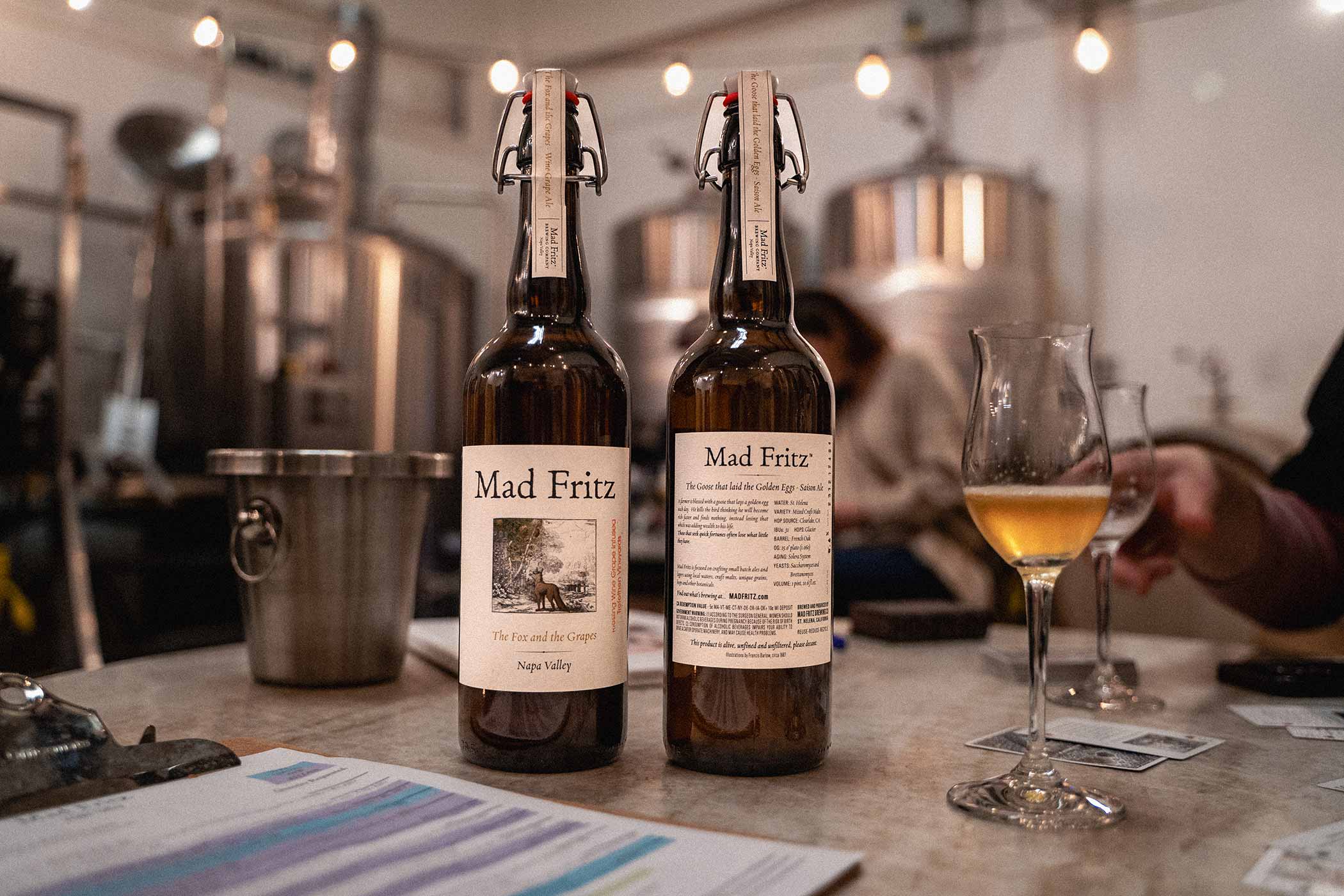
Photography courtesy of Magic Muncie | Hop Culture
“We were infusing ganja into the beers!” exclaimed Zacherle while Muncie and I sat on grey stools around granite-topped barrels serving as tables in the tiny taproom. “We’re half-baked doing this, so we’re spilling s**t all over. We had these rookie points down at the bottom if you started making mistakes, so I was always doing the most work and getting all the rookie points.”
Zacherle called some of it silly, but “they’re all calculations. This was before the internet, so you did what you could,” he pointed out. “You can see secrets on these pages!”
And with each beer, Zacherle’s skills improved.
By 1994, he brewed with all grain. “You can see a double decoction right there,” he pointed to a recipe in his little black binder, where the beers really mark the years.
On the next page, a People’s Porter reminded Zacherle of the year he started going to UC Davis to get his BS in Fermentation Science.
Another recipe recalled when he lived in an apartment on Colgate Avenue, where he kept yeast slants in his fridge and set up a ten-barrel brewing system.
“I was so geeked out!” he reminisced.
After completing the Masters Brewing Program in 1996, Zacherle started working at Anderson Valley Brewing Company (AVBC).
“But after about six months, I went into [then-AVBC-Owner] Ken Allen’s office,” said Zacherle, who stood propped up on crutches after a recent sledding accident. “He had just smoked a joint, and I was hot boxed in there. And I’m like, dude, I got to make, like, $30,000 a year to stay on.”
From Northern California Around the World and Back Again
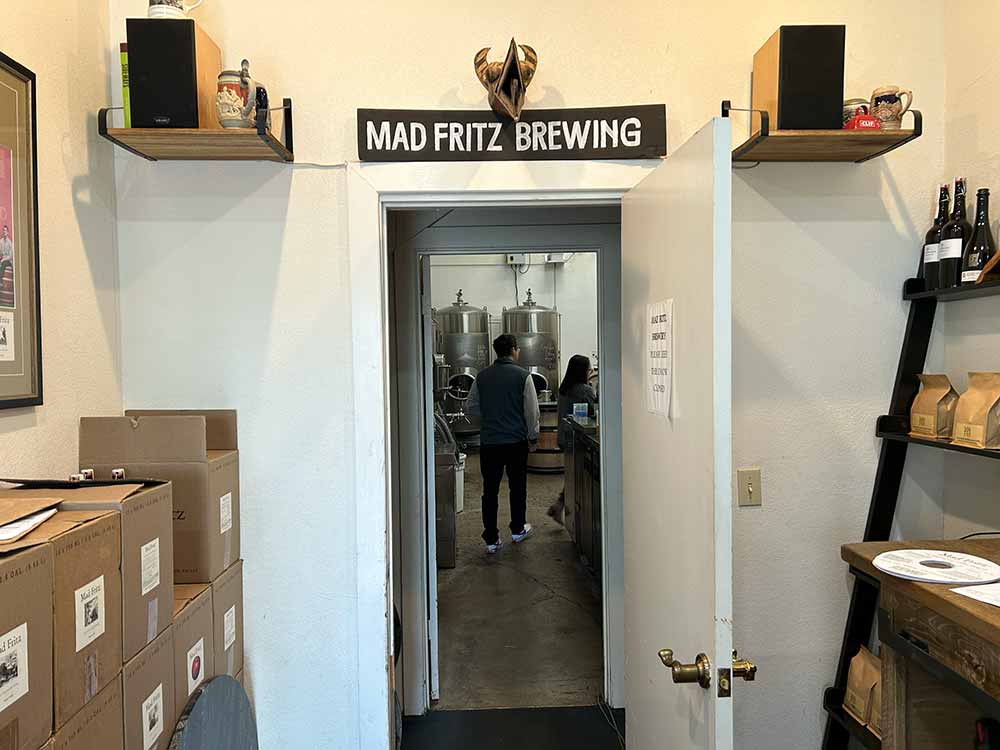
Photography courtesy of Grace Lee-Weitz | Hop Culture
So the aspiring brewer pivoted, putting all his brewing equipment in storage and traveling the world, from Australia to France, making wine.
But Napa Valley called him back “because it was the leading edge of wine,” explained Zacherle.
He became the assistant winemaker under Bo Barrett at Chateau Montelena, what Zacherle considers his “alma mater.”
At the vineyard, which sourced ninety percent of its fruit, Zacherle learned the importance of local.
“I had this little Volkswagen R32, and I was ripping around the Valley, Sonoma, and Mendo just purchasing fruit,” he recalled. “I was just having a blast!”
Today, Zacherle is the head winemaker at David Arthur Vineyards, where he’s been for the last seventeen years.
Zacherle could only meet us in the morning the day we visited because he had to take some Mad Fritz beer to Barrett’s seventieth birthday party.
“I’ve got a green pilsner I’m going to be pouring him,” Zacherle shared. “I wouldn’t normally make a green beer, but for Bo, I’ll do it!”
Yes, you’re reading this right. Zacherle is currently still a head winemaker for a significant Napa Valley winery. Mad Fritz? That’s just his side passion project.
Actually, the brewery is like a side project to the side project.
In 2006, Zacherle started Zacherle Wines with his now-wife Whitney Fisher, and about six years later, put the gears in motion for Mad Fritz.
“We’re using our day jobs to kind of crutch these passion projects along while building and cultivating a following for what we love to do,” said Zacherle, who built Mad Fritz’s two-barrel system from old winemaking fermenters (seventy-five gallon SS drums, to be exact) from Zacherle Wine.
At Mad Fritz, one passion feeds into another.
The Origin [Beer] Story
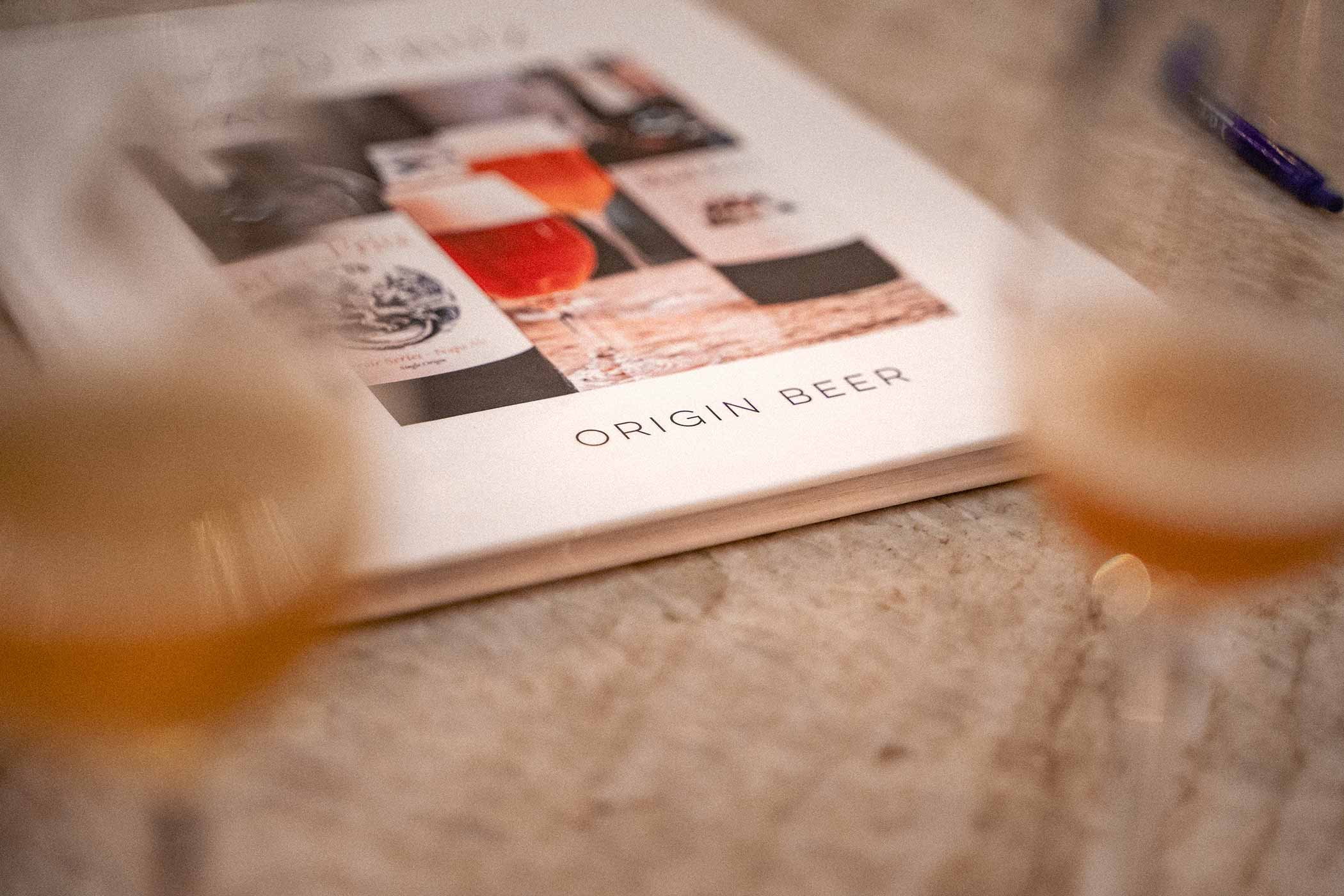
Photography courtesy of Magic Muncie | Hop Culture
For Zacherle, brewing and winemaking are all about time and place. If you had to sum Mad Fritz up in one word: terroir.
If Zacherle summed it up, he’d use two words: origin beer.
“The concept was, well, what do we talk about when we talk about good wines?” explained Zacherle. “We talk about where the grapes are growing, where the grapes are from, this place, the people that help make that happen. But the growing of the grapes at that place, that’s the magic connection. And the best wines come from a place in time that’s cultivated and cultured into a product that has very little, ideally, influence from other factors.”
For each ingredient in his beers, Zacherle thinks about the origin.
The Wacky Water Expeditions
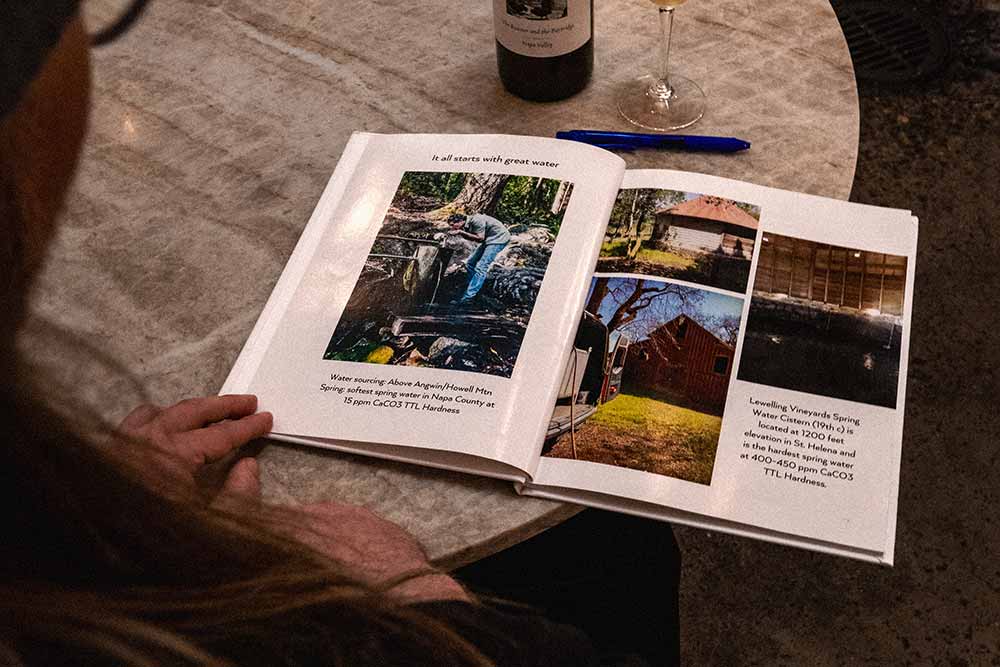
Photography courtesy of Magic Muncie | Hop Culture
Remember Zacherle zipping around Northern California, searching for the best produce for Chateau Montelena wines?
He does the same for water, sourcing from all over the area.
Zacherle found a spring in Angwin, CA, for a version of a pilsner called Jupiter and the Camel.
“It’s the softest water in Napa Valley,” he told us, mentioning he had a 350-gallon reservoir built into his beer van full of the local H20 that we could taste test right now. “You can see the difference! And that’s kind of how geeky I get with beer.”
For this water, Zacherle drives up 2,000 feet in elevation outside the little town of Angwin, where you can find a centuries-old spring right off the side of the road. To collect the water, he hikes a few hundred feet from a pull-out to a simple cistern with a spout.
He considers the water very clean, smooth, and polished, perfect for German-style lagers.
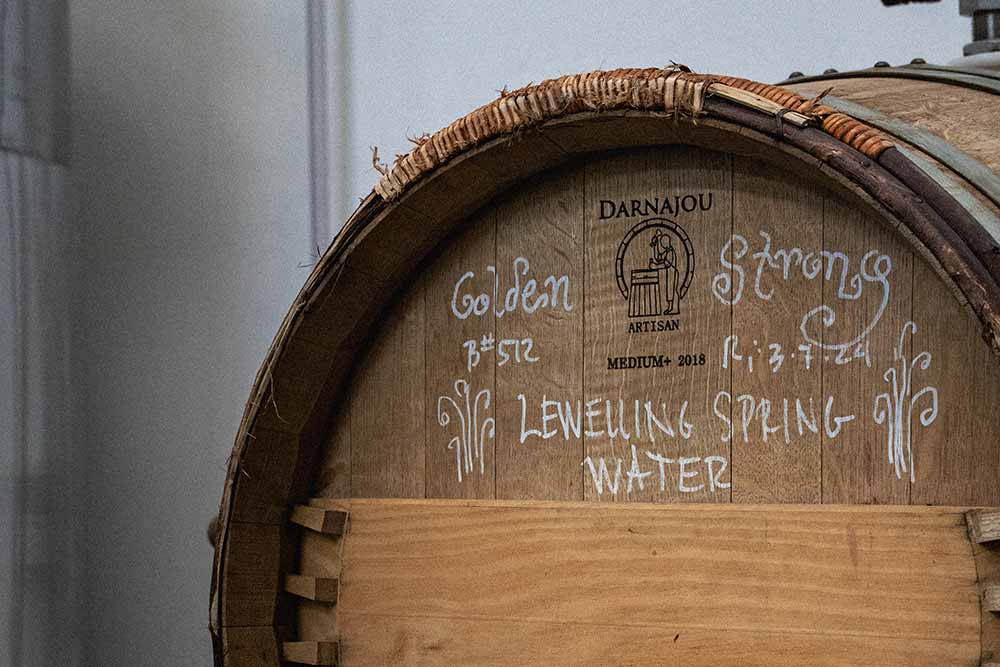
Photography courtesy of Magic Muncie | Hop Culture
For a Belgian golden strong ale, on the other hand, he used Lewelling spring water, which is the hardest water in Napa Valley, according to Zacherle. “It’s from this amazing spring, and when you taste it, you’re like, oh my God, that’s so good!” he said. “And that’s what you get to celebrate every time you have that beer.”
Perhaps no series of beers sums up Mad Fritz’s approach to brewing better than its single-origin beers. With these, Zacherle picks a different county in California, sourcing everything from that area—water, hops, grain, etc.
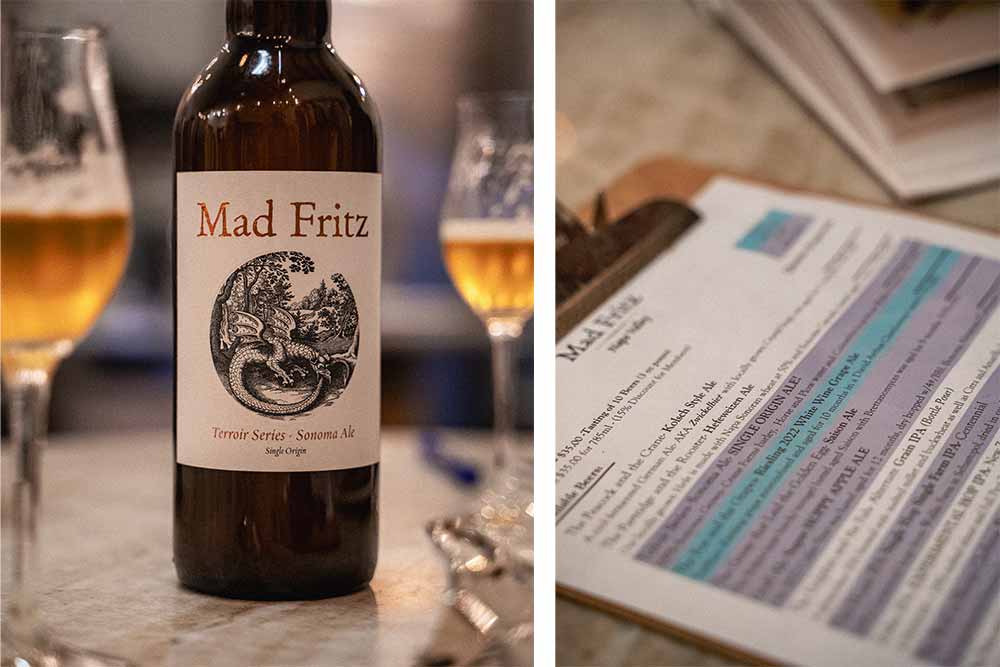
Photography courtesy of Magic Muncie | Hop Culture
In the past, he’s focused on Sonoma. When we visited, he’d been working on a beer specifically from Mendocino County.
For the water, Zacherle tapped a friend, Jake Fetzer, who owns Masút Vineyard and Winery in Mendocino County.
“I was up at Jake Fetzer’s place checking his setup out, and he’s like taste our beautiful water coming off his well,” explained Zacherle. “Of course, it’s up this gnarly road. That’s where the four-wheel drive on the van comes in!”
For some, the extra effort to source water may seem extreme. For Zacherle, it’s just one part of telling the story behind his origin beers.
Grain is another.
The Great Grain Pilgrimage
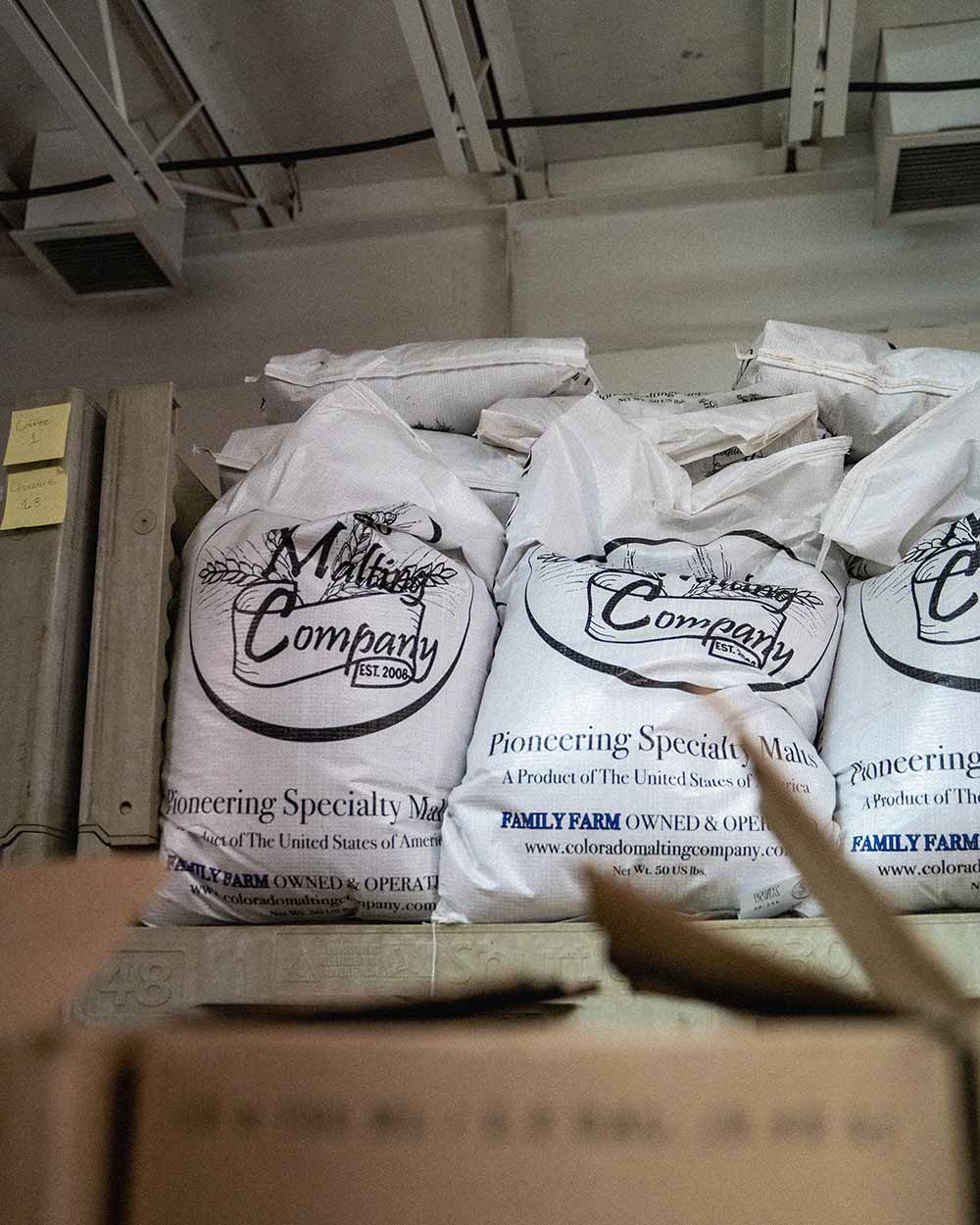
Photography courtesy of Magic Muncie | Hop Culture
At Davis, Zacherle learned how to brew with commodity grain at spec. You order a product, it shows up from a big producer on a palate, and you check it off. He learned something different as a winemaker, working with ingredients from the land he touched and felt.
“You can do anything by the numbers, but a lot can get missed,” explained Zacherle. “A lot of the craft and art is being able to transcend the numbers—to read and interpret them but also look past them and be like, how does it taste?”
When Mad Fritz started, Zacherle knew he didn’t want to brew with commodity grain, so he contacted the closest maltster, Rebel Malting, in Reno, NV.
“There was no one in California malting back in 2013,” explained Zacherle.
Owned by Lance Jergensen, one of the first brewers at New Belgium, Rebel Malting grew malt in Fallon, NV, malting it in Reno.
“We now own his kiln,” Zacherle said as he showed us around the tiny malting facility a couple of doors down from the taproom (Zacherle says the malt house makes about 500 pounds every batch). In addition to malting small batches on his own, Zacherle also sources from various craft maltsters around the country, including Colorado Malting Company, Mecca Valley Malt, and Deer Creek, to name a few.
“We’ve leaned towards the more estate-prone malts,” said Zacherle. “I really wanted it to be like a wine in that sense, where you got it and knew [where it was from].”
That’s why Zacherle lists the origin and variety of grain on the back of each of Mad Fritz’s labels.
Again, hence, origin beer.
“It is all about the authenticity of origin,” he said. “That’s what’s so cool. We’re one of the few breweries in the world that has a hop kiln and a malt house. We’re sourcing water. We’re taking things to a really extreme source origin level. I built the infrastructure over time because that’s what we do.”
“Anyone can paint by the numbers, but that doesn’t make them a Monet,” I told Zacherle.
He agreed, replying, “You lose the soul.”
At Mad Fritz, Every Beer Has a Soul
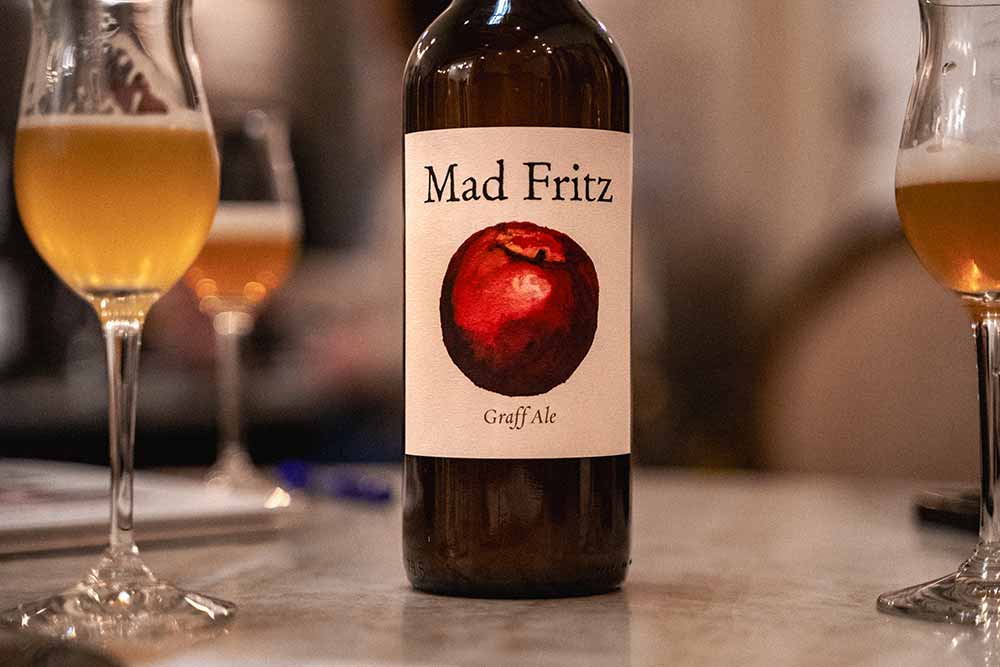
Photography courtesy of Magic Muncie | Hop Culture
One might call Mad Fritz Zacherle’s little crazy laboratory. When Zacherle starts talking about the pursuit to find the perfect water source or the right white fig to complement a kölsch, he lights up.
His radiant and infectious energy is hard to ignore. “I’m just going to bring out different things and kind of shotgun you with different beers,” he excitedly warned us, plopping down the first beer of the day, a taster full of enticingly clear, gold liquid.
The Peacock and the Crane
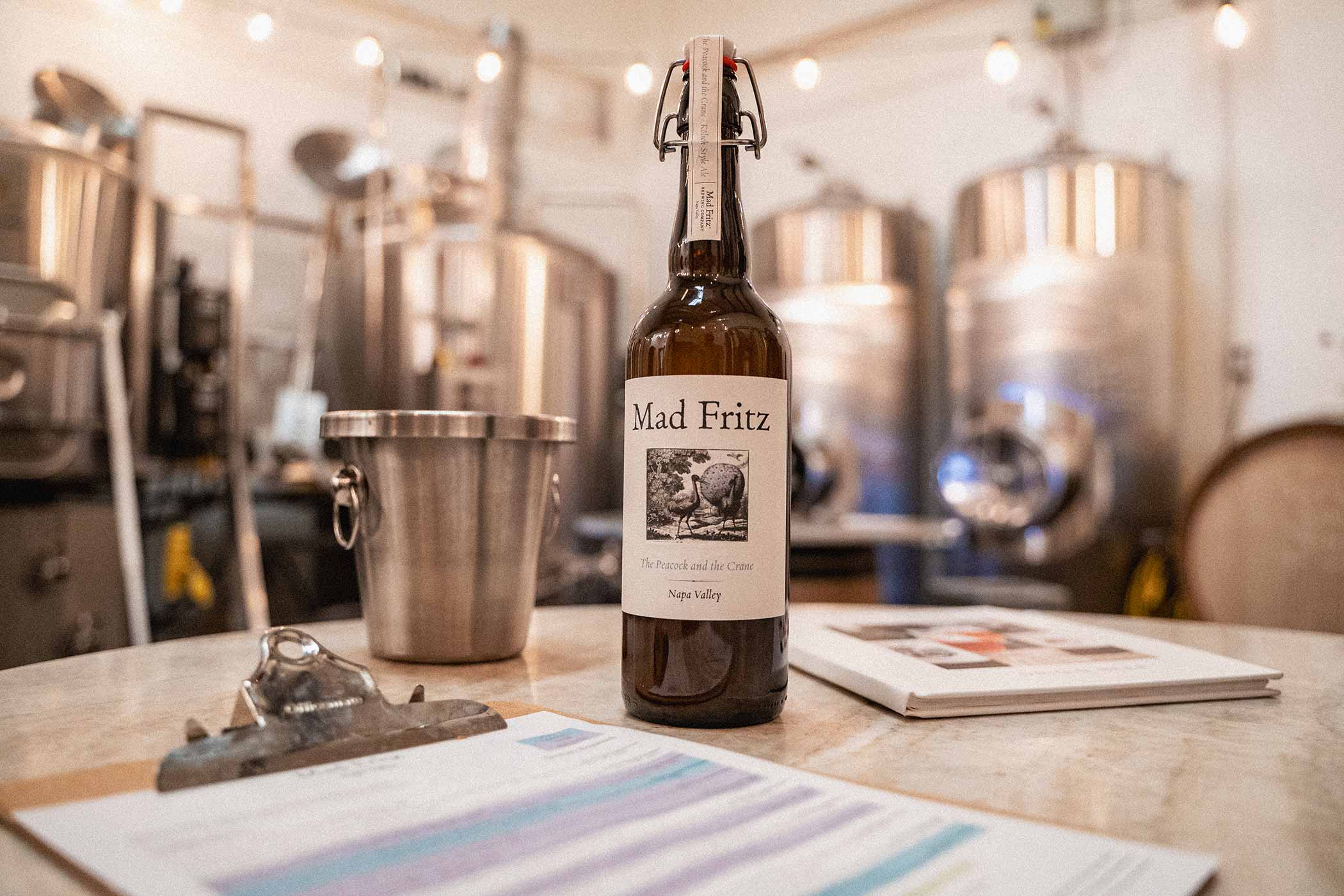
Photography courtesy of Magic Muncie | Hop Culture
Brewed with a base malt of Scarlet from Alamosa, CO, this unique kölsch includes St. Helena well water and Hallertau hops. Aged in Riesling or Chardonnay barrels for three to four weeks, the unique variant we tried gets an infusion of local white fig from a few local trees at the house of Rombauer Vineyards Founder Koerner Rombauer in Napa Valley. (“We gleefully grabbed them when they asked us if we needed any!” said Zacherle).
“Fig is just one of those things that are so raw and have a vegetative dimension to it,” said Zacherle, explaining why they also dry-hopped this iteration for seven days with one pound per barrel of whole-leaf Teamaker hops grown in Sonoma County at Blossom and Bine Hop Yard. “We wanted to add a little noise to the nose to make it wiggle a little more.”
The Peacock and the Crane then spent a month in foeders before bottle conditioning, looking for that synergy between fruit and vegetal matter.
“I’m trying to have it be a protagonist in the beer without taking over the beer,” shared Zacherle.
When he first poured it for his wife, she noticed a lot of stone fruit character.
We found agreed, but also found notes of green grape and Chardonnay.
The Bear and the Bees: Rancho Chimiles Honey
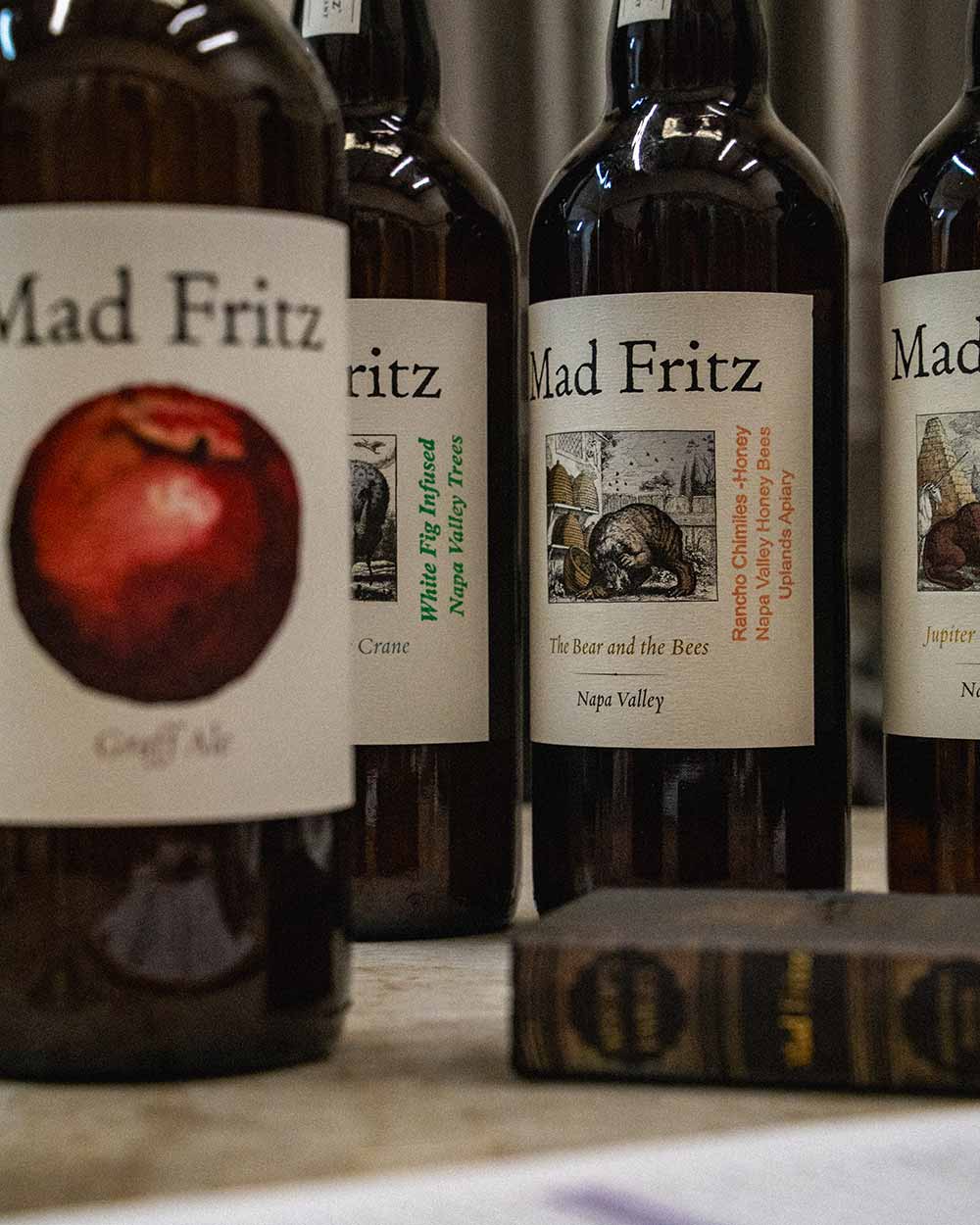
Photography courtesy of Magic Muncie | Hop Culture

Photography courtesy of Magic Muncie | Hop Culture
As Zacherle hobbled back from the taps, he dropped another beer in front of us: a honey ale brewed with single-hive honey from Rancho Chimiles.
Barrel aged for a month and a half, The Bear and The Bees “is all about the honey,” said Zacherle, who chased the bee-derived ingredient through a hopback so it doesn’t boil. “It just gets zipped in there, so we retain as much integrity of the honey as possible, and that’s really what you’re tasting and enjoying.”
Personally, I tend to shy away from honey beers because I often feel the honey causes an imbalance, skewing too far into sweetness. Very few honey beers truly nail a balance with the nectarous ingredient.
This beer did in spades. Zacherle was right: We only tasted the integrity of the honey.
The King and the Frogs
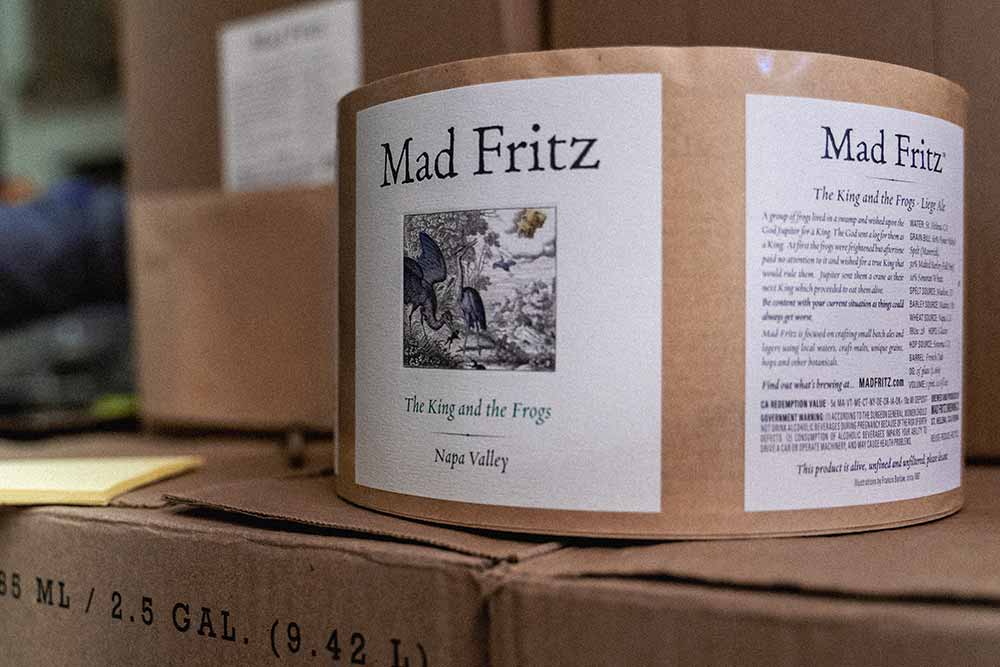
Photography courtesy of Magic Muncie | Hop Culture
We were the first to try The King and the Frogs, a historical Belgian style called liege.
With sixty percent Mad Fritz floor-malted spelt beer, The King and the Frog ferments with Belgian yeast. “There is a multi-spicy, yeast thing going on,” said Zacherle. “There’s a caramelly, honey, biscuity thing going on, too.”
“You’re drinking something that’s a reflection of just a lot of freaking work,” he said.
The Larks in the Corn
Perhaps one of the most unique beers we heard about and yet couldn’t try (while out of bottles, Zacherle said he did have one keg left next door that, if we were so inclined, we could drag over. We didn’t, but sounds like we should have!) was The Larks in the Corn.
For this blue corn pale ale, Mad Fritz sourced organic blue corn from New Mexico, sometimes floor-malting the grain themselves and other times milling it at Bale Grist Mill, one of the few operating grist mills west of the Mississippi.
“The beer just has this crazy stone fruit thing with the corn,” said Zacherle. Malting this blue corn gives this beer an added layer of complexity.
“There are just reactions and microflora that take over during the process that added a dimension to the beer that couldn’t be replicated any other way,” explained Zacherle, who emphasizes that this is a beer that defined itself; he just put the ingredients together. “[Other than that], It’s a really simple beer.”
The rest of the grist (seventy-four percent) comes from two-row Copeland from Siskiyou County, CA, malted by Admiral Maltings in Alameda, CA.
While hops include Sonoma County Cascade.
Zacherle says this beer, above all others, causes significant reactions. “[People will] be like, oh my God, that was the first beer I had of yours that just blew me away!”
The Goose that Laid the Golden Egg
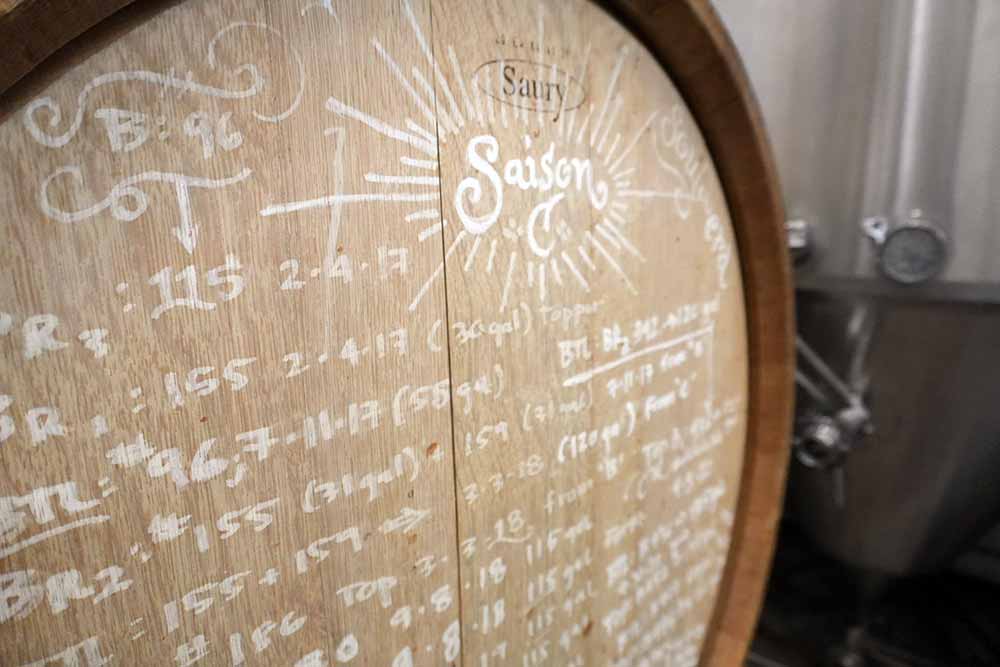
Photography courtesy of Grace Lee-Weitz | Hop Culture
When I first walked into the 250-sq-ft taproom, a specific wooden barrel in the back caught my eye.
Unlike the others, this one had tons of white chalk markings covering the entire surface. In the center, the word “Saison,” outlined with rays, like the sun. Below are scribbled notes: “BR3 : 155 2-4-17” or “BR1 : 155 2-4-17 (30 gal) topper.”
Zacherle’s eyes gleam when we start talking about it.
The Goose that Laid the Golden Egg is a saison fermenting in a barrel that Zacherle has never emptied or cleaned since 2017.
No, it’s not a riddle. Following the solera method, the saison becomes a compilation of batches from the past. “I’ll add some, take some out, add some, take some out,” explained Zacherle, who adoringly calls the 600 L barrel the “Soul-Era” because “The beer has Brett, which is kind of funky, thus it has got soul!”
An approach to aging everything from sherry and wine to beer, solera keeps a batch of fermented beverage constantly in a barrel. Every year, you add a small portion of adolescent beer to the aging batch, draining some off for bottling and enjoyment.
As Hop Culture Freelancer Andy Crump wrote, “The process boils down to the magic of fractional blending, a painstaking aging method that guarantees a product that’s both consistent and unique from one batch to the next.”
Those markings on the barrel indicate different batches Zacherle has added. “Basically, the first fill used three lots: 96, 115, and 155, with 155 to finish filling the barrel,” he explained. “Then we bottled 97 and topped it again with 155 (7.2.2017)…Now we are at batch 504!”
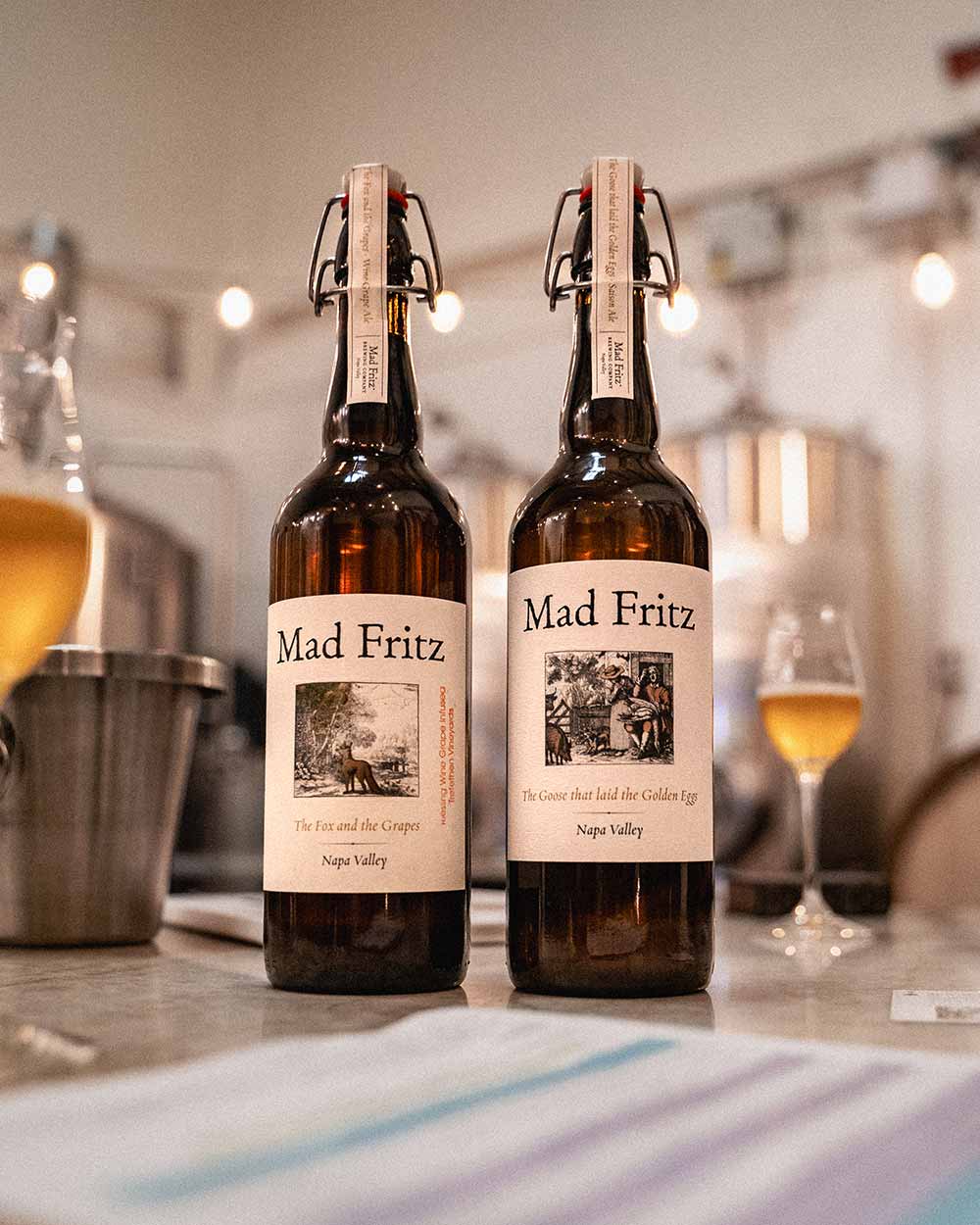
Photography courtesy of Magic Muncie | Hop Culture
That’s the magic of The Goose that Laid the Golden Egg. “It’s one of these beers that we just always have to have because the people want some funk!” Zacherle exclaimed.
We found the funk very approachable yet not overpowering.
It’s a living, breathing beer that endlessly replenishes itself, feeding its own soul. In other words, it’s a pretty fitting beer for Zacherle to make at Mad Fritz.
At this point, and over a few hours, Zacherle had plunked numerous beers in front of us, even crutching over to show us his malt house. Yet his zest for talking about and showing us his work hadn’t waned.
“I figured you had to try the saison, but we also have two IPAs and a hefe. Yeah, we could be here for hours,” he said jokingly.
Muncie chimed in. “[Last time], I was here for like two hours before you even got here. And when you did get here, it was just like, let’s keep going!” he said. “We were about to go get tacos over in Sonoma but said screw it because we wanted to try more beers with you.”
The Lion and the Mouse
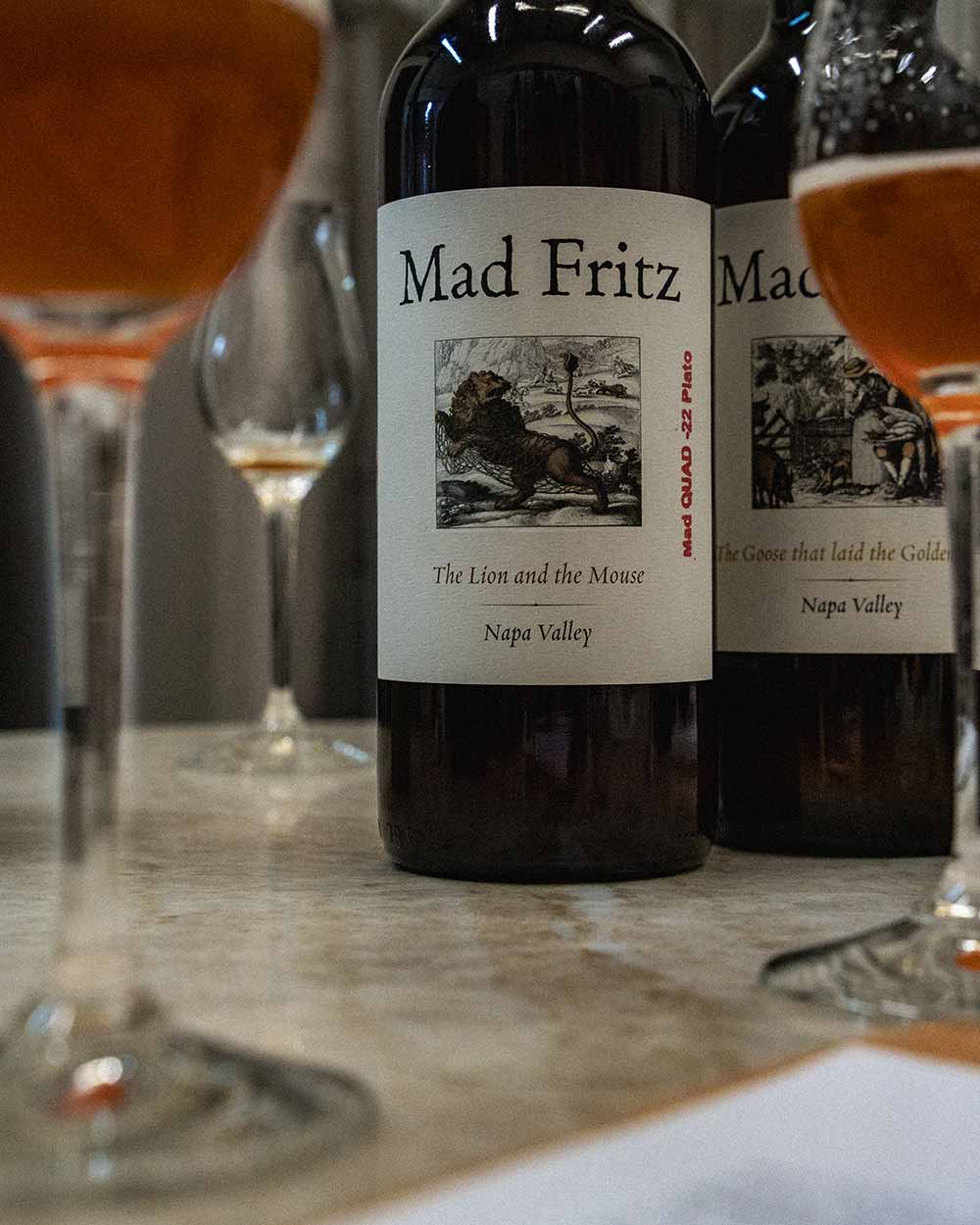
Photography courtesy of Magic Muncie | Hop Culture
Zacherle wasn’t joking. He kept pouring tasters for us to try.
“I’m going to force a few more because we’re going into the dark zone,” he said with a smile.
Skipping Mad Fritz’s dubbel and going straight for the Belgian Quad, Zacherle questioned us with a smirk. “What do you think the alcohol is on this?”
“If I had to guess, I’d say six or seven,” Muncie replied.
Zacherle just smiled and said one thing: 10.7% ABV.
“Oh, my God, it’s so good,” said Muncie.
I replied, “Got to be careful with that one! I don’t taste the alcohol, that’s for sure.”
Muncie asked what went into hiding the high ABV.
“The yeast in the malt; it’s got to be,” replied Zacherle. “It’s just the way that f**king yeast does it; I don’t know, but it’s so gnarly!”
The Wolf in Sheep’s Clothing
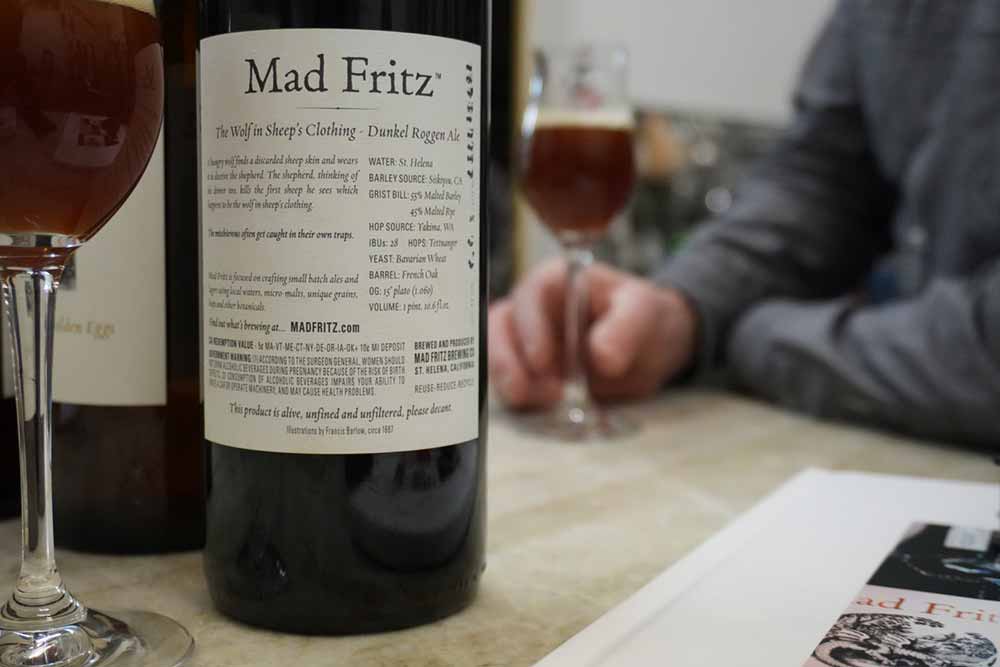
Photography courtesy of Grace Lee-Weitz | Hop Culture
Of the probably seven to nine beers we tried during our time at Mad Fritz, the roggenbier, The Wolf in Sheep’s Clothing, just stuck in our minds.
“It’s forty-five percent malted rye with no hull. So when you’re making this beer, it’s a soupy rye,” says Zacherle, noting this was only the second time they’d brewed the beer. “I like to say it’s a banana pumpernickel bread beer.”
Which is exactly what this beer tasted like. Thick, rich, rye, dry. Just delicious.
“When I think about making a new beer for Mad Fritz, it has to be something that’s just kind of a different category; it just touches a different flavor spectrum,” espoused Zacherle. “And this was something that was clearly like that.”
At Mad Fritz, Every Beer Has a Fable
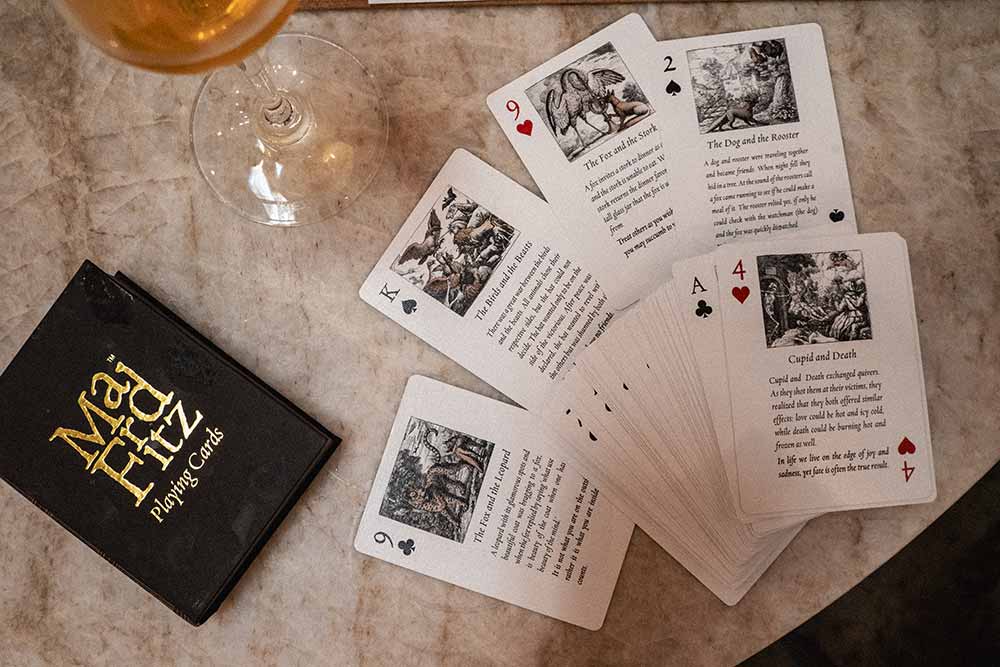
Photography courtesy of Magic Muncie | Hop Culture
You may have noticed a theme with some of Mad Fritz’s beer names…
The Peacock and the Crane.
The Goose that Laid the Golden Egg.
And the Larks in the Corn, for example.
An idea from Whitney, every beer at Mad Fritz comes as a fable. (For what it’s worth, Zacherle says he thought of the brewery’s name—a combination of the pair’s children, Madeline and Fritz.)
With each new beer, Zacherle comes up with a name and writes the fable behind it himself, adding it right on the label (a fable label?).
For example, for the Peacock and the Crane:
“A beautiful Peacock mocks the Crane for its plain, simple plumage, the Crane wisely replies he is able to fly while the Peacock remains a flightless bird
We each have distinctive attributes that are unique, and pride in these strengths can blind us to appreciation of others and what they can contribute.”
At one point during our tasting, Zacherle fanned out a flight of cards in his hand, shuffling and reshuffling the deck.
Each card features a beer name, fable, and illustration.
An idea Zacherle attributes to his wife’s cousin.
Zacherle wouldn’t let me leave without taking a deck, which now sits right on my desk. It is a reminder of stepping into the looking glass with Mad Fritz, even if just for a few hours.
The Moral of the Story Is…
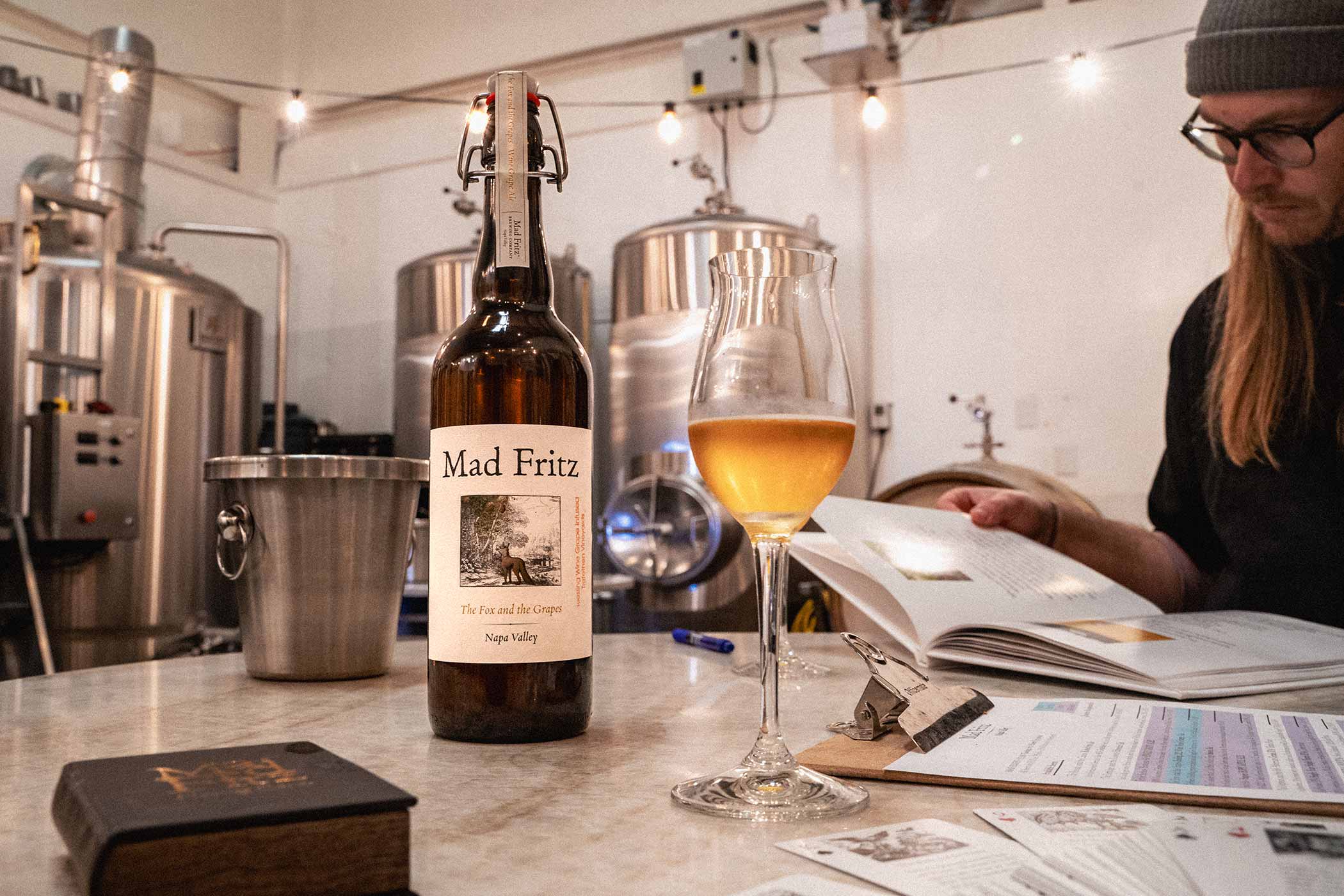
Photography courtesy of Magic Muncie | Hop Culture
Everything at Mad Fritz is just a little different. Like playing one of those “spot the differences” puzzles, where you have to find the disparities in two seemingly identical photos. Compare Mad Fritz to another brewery, and you just start seeing the nuances that make it memorable.
For example, they are membership-based only.
“We were probably the second or third brewery to have a subscription,” said Zacherle, citing The Bruery as one of the first.
To get a taste of Mad Fritz’s creations, you either need to be a member or make an appointment to visit the tasting room.
“Our beer doesn’t go anywhere other than memberships,” he told us. “You’re tasting some today because you’re here.”
Since we’re not members, our visit was our only opportunity. We won’t find these beers in the wild or on store shelves. Only in St. Helena can we taste the unusual and exceptional.
Of which there aren’t many anyway. Zacherle thinks 2019 might have been the brewery’s biggest year, producing 200-230 barrels. Last year, he put the number at 180, and he believed they’ll hit around 200 in 2024.
And the small size makes Mad Fritz’s bottles coveted.
So far, the somewhat risky choice to stay small and specialized has proved fruitful.
Mad Fritz released its first subscription in September 2014, selling out nearly one hundred bottles immediately.
Opening for new members every quarter, Mad Fritz now has over 500 members with a waitlist for more.
“The best way to become a member is to visit us, call or email us,” offers Zacherle. “We can make sure you’ll get in for the following quarter’s release!”
This model means that Zacherle can brew whatever he wants. “That allows us not to make hazy juices. We don’t subscribe to one style of beer, and that’s the beauty of it,” explained Zacherle, who notes they also don’t can or sell off-premise. “There are so many damn beers that I like to say I struggle with a condition known as OCBD: obsessive-compulsive brewing disorder.”
When I asked if there was anything they don’t brew, Zacherle emphatically answered, “Yeah, pastry stout.”
On average, Zacherle brews a seven-barrel batch once every week and a half. Since opening, he has had forty-five beers in rotation—many bifurcated to create cool variants, like that white fig kölsch we tried.
“The variants are usually the ones that hit the hardest,” he said with a smile.
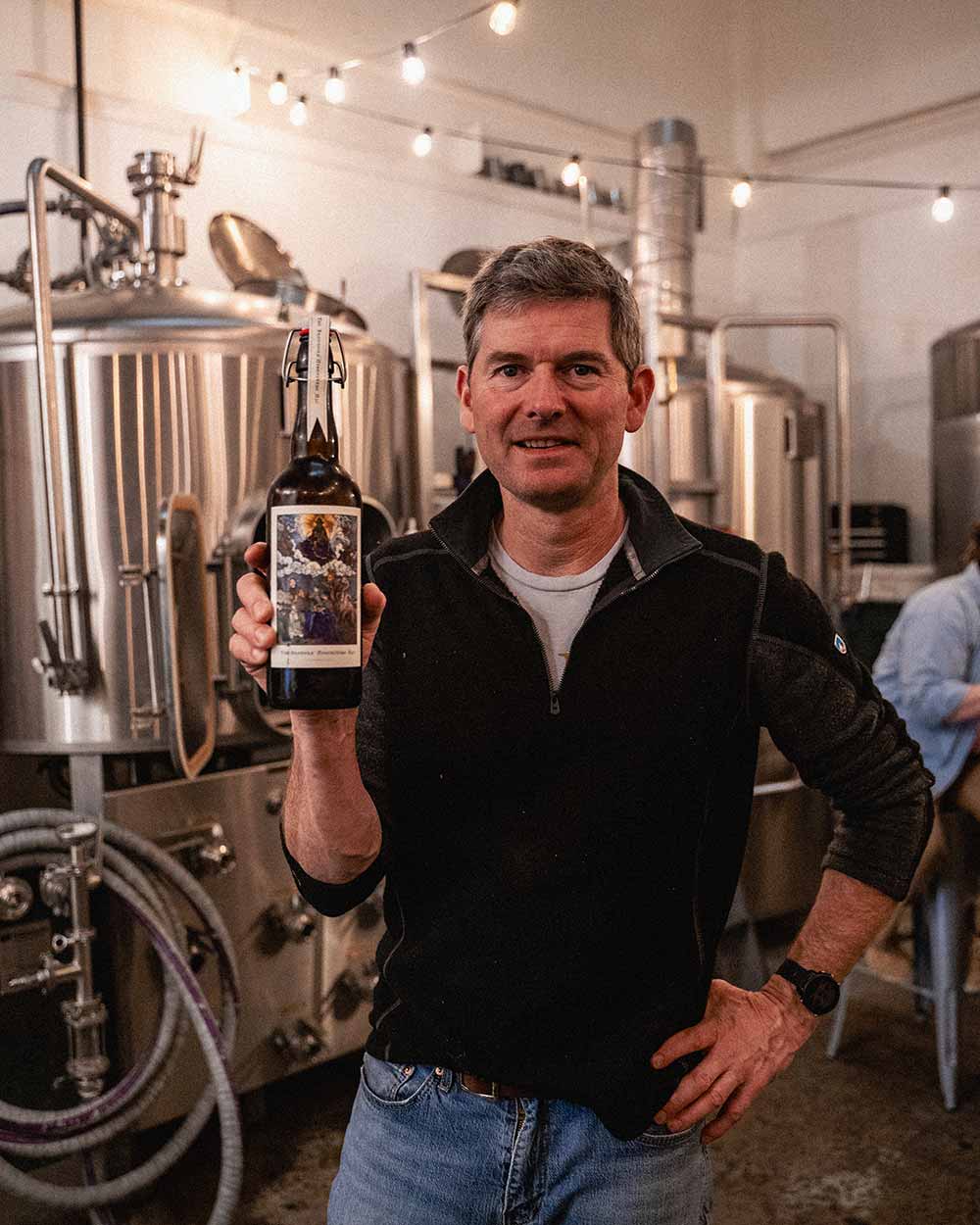
Photography courtesy of Magic Muncie | Hop Culture
You can tell Zacherle has poured his heart and soul into this origin beers.
At Mad Fritz, “I feel like myself more than anything else,” he told us.
As we wrapped up our last little taster, Zacherle left us with what kind of seems like the moral to the entire story: “We’re most comfortable around our beer friends, our beer people, and that’s what’s important—finding your special place.”
Mad Fritz is truly a special place, and we’re so happy we found it.
Now, it’s your turn.

